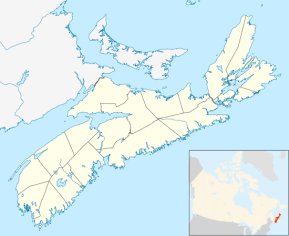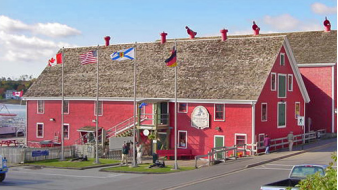Lunenburg, Nova Scotia 作者: 来源: 发布时间:2021-12-02
I.Population and Area
-Area (2016)
•Land: 4.04 km2 (1.56 sq mi)
-Population (2016)
•Total: 2,263
II.Natural Geography (environment and resources)

-Lunenburg is a port town on the South Shore of Nova Scotia, Canada. Founded in 1753, the town was one of the first British attempts to settle Protestants in Nova Scotia in an effort to displace the French colonial Roman Catholic Acadians and indigenous Mi'kmaq.
-The economy was traditionally based on the offshore fishery and today Lunenburg is the site of Canada's largest secondary fish-processing plant. The town flourished in the late 1800s, and much of the historic architecture dates from that period.
-In 1995 UNESCO designated it a World Heritage Site. UNESCO considers the site the best example of planned British colonial settlement in North America, as it retains its original layout and appearance of the 1800s, including local wooden vernacular architecture. UNESCO considers the town in need of protection because the future of its traditional economic underpinnings, the Atlantic fishery, is now very uncertain.
-The historic core of the town is also a National Historic Site of Canada.
-Physical geography
•Lunenburg is in a natural harbour at the western side of Mahone Bay, about 100 kilometres southwest of the Halifax Regional Municipality.
•The area is built largely on Cambrian to Ordovician sedimentary deposits. The last glacial period transformed the landscape. Glaciers abraded and plucked at the bedrock during their advances across the country, creating various deposits that vary in thickness, including drumlins, which are a key feature of Lunenburg County.
•The coastline in the area is heavily indented, and the town is on an isthmus on the Fairhaven Peninsula, with harbours on both the front and back sides.
-Climate
•The climate of Lunenburg is humid continental, bordering on an oceanic, with warm summers and mild winters, due to Gulf Stream moderation, which also causes seasonal lag. Generally Lunenburg is cool and rather wet. The average temperature is 6.5 °C. Even the driest month, July, sees 85 mm of rain, while the wettest, December, sees 149 mm. August is the warmest month, with an average temperature of 17.1 °C. February is the coldest with -4.4 C on average.
III.ECONOMY
-GDP in 2018: US$ 277,289

-Website: https://fred.stlouisfed.org/series/GDPALL51111
IV.Industrial Characteristics
-According to the 2016 census the most common National Occupational Classification was sales and services, with 24 per cent of jobs. By the North American Industry Classification System about half of all jobs were in health care and social assistance, accommodation and food services, manufacturing, and retail. High Liner Foods runs Canada's largest secondary fish-processing plant in the town.
-The town's architecture and picturesque location make it attractive to the film industry. Films set in New England but filmed partly in Lunenburg include The Covenant and Dolores Claiborne. The 2010 Japanese movie Hanamizuki was partly set and filmed in Lunenburg and the science fiction television show Haven was partly filmed there though it is set in the United States. The 2012 film The Disappeared and the 2020 television series Locke & Key were filmed in Lunenburg.
-Infrastructure
•Water Utility Supply
-Dares Lake is located 4 km from the Town of Lunenburg in the Municipality of the District of Lunenburg. It provides an abundant supply of clean water with a yield of 3,000,000 gallons approx. per day during a dry season. Water flows by gravity from Dares Lake through two cast iron pipes, one 6" and one 24" through an intake chamber, screen house and pumping station located 62' above mean sea level, 550' from the lake. Water is pumped to the Water Treatment Plant located at 524 Northwest Road.
•Dares Lake Watershed Protection
-In 1972, 518 acres of land surrounding the Town’s water supply at Dares Lake were designated a protected watershed area. Provincial Regulations protect the Town’s water supply from commercial, residential and recreational activities that could have a negative impact on Dares Lake water quality. The Town is also developing a Source Water Protection Management Plan to provide additional protection measures for the Dares Lake water shed.
V.Attractions
1.Fisheries museum of the atlantic

-Housed in a bright red building on Lunenburg’s waterfront, the Fisheries Museum of the Atlantic is easy to spot. Inside, visitors will find an extensive (and hands-on) aquarium, exhibits, and the Ice House Theatre with films showing throughout the day. Outside, people can climb aboard the Theresa E. Connor, Canada’s oldest dory schooner, and Cape Sable, a steel-hulled side trawler. Retired fishermen and captains act as Historic Interpreters onboard the vessels.
-Address: 68 Bluenose Drive, Lunenburg, Nova Scotia, B0J 2C0, Canada
-TEL: +19026344794
2.Hidden Gems Tour Lunenburg

-Sit back, relax, and enjoy a tale or two on this short 60-min tour. We’ll explore hidden gems and best kept secrets along the Lunenburg county coast on our way to the ocean just 15 minutes out side town! At Seaweed Tours, we believe that every day is a good day for adventure.
-Our tours are designed for you to take in the beauty and awe, to ignite your senses and to inspire new stories of your own that you can take and sharing when you get back home.
-The town of Lunenburg is beautiful for sure ....but come with me...there's so much more to see!
-Booking website: https://www.placepass.com/things-to-do/V28Hi371Lg70p7-hidden-gems-tour-lunenburg
3.Knaut–Rhuland House

-Knaut–Rhuland House is a historic 18th-century house in Lunenburg, Nova Scotia, Canada. It is a designated a National Historic Site of Canada, as well as a Provincially Registered Property under the provincial Heritage Property Act. It is located within the Old Town Lunenburg World Heritage Site. The Knaut–Rhuland House is owned by the Lunenburg Heritage Society, which operates a museum in the house open to the public during the summer.
-The houses' design is British Classicism. The entrance door is framed by sidelights and there is a transom window overhead. All windows are multi - paned six over six and many have the original old glass.
-The foundation is stone, more than two feet thick, and is built around two chimneys.
-The frame is post and beam, consisting of hand-hewn timbers. These are "numbered" with hatch marks suggesting that it was prepared off-site. The interior walls and ceilings were plastered (reinforced with horse hair) and applied to split lath. The floors are pine and there are seven fireplaces. There are original mouldings and wood work in some rooms.
-There are furnished rooms on the ground floor providing examples of the style of furnishings that would be known to the first two owners. An exhibition called "Our Spiritual Heritage" contains a display of old Bibles and prayer books, some dating from the time of the "Foreign Protestants" who came to Lunenburg in 1753. This exhibition contains display panels describing Lunenburg’s churches, which are amongst the oldest in Canada. There is also a room depicting the craft activities of the 18th and 19th centuries, with among other items a walking wheel, spinning wheels and wool winders.
-Upstairs, the exhibition gallery provides a history of Lunenburg from 1753 when the Foreign Protestants settled in the town and local area.
VI.History
-The Mi'kmaq lived in a territory from the present site of Lunenburg to Mahone Bay. As many as 300 inhabited the site in the warm summer months. French colonists, who became known as Acadians, settled in the area around the 1620s. The Acadians and Mi’kmaq lived peacefully and some intermarried, creating networks of trade and kinship. In 1688, 10 Acadians and 11 Mi’kmaq were resident with dwellings and a small area of cultivated land. By 1745 there were eight families.
-When Edward Cornwallis, newly appointed Governor of Nova Scotia, visited in 1749, he reported several Mi’kmaq and Acadian families living together at Mirliguèche in comfortable houses and said they appeared to be doing well.
-Britain and France carried their military action in Europe in the 1700s to the New World. Under the 1713 Treaty of Utrecht, France ceded the part of Acadia today known as peninsular Nova Scotia to Britain. But the inhabitants of the area did not welcome the new regime. To guard against Mi'kmaq, Acadian and colonial French attacks, the British erected Fort George in 1749 at Citadel Hill Halifax and founded the town of Halifax. Later that year, Cornwallis ordered Mirliguèche destroyed.
-The British sought to settle the lands with loyal subjects, and recruited more than 1,400 foreign Protestants, mostly artisans and famers, from Europe in July 1753 to populate the site. Led by Charles Lawrence, the settlers were accompanied by about 160 soldiers. They assembled prefabricated blockhouses and built a palisade along the neck of land where the village was laid out. The settlers spent the summer building shelters for the winter and, not having been able to conduct any fishing or farming, had to be provisioned from Halifax. When the settlers became dissatisfied with the distribution of provisions, they rose in armed rebellion, only to be put down by troops led by Colonel Robert Monckton. Others defected to the Acadian side. In 1754 the town had a sawmill and a store.
-In 1755, after the expulsion of the Acadians, the British needed to repopulate vacated lands. It offered generous land grants to colonists from New England, which was experience a severe land shortage. Today these immigrants are known as the New England Planters, planters being an old word for colonist. Lunenburg was raided in 1756 by Mi'kmaq and allies, and afterwards. The British responded with the Lunenburg Campaign of 1758. Hostilities with Mi'kmaq ended around 1760.
-During the American Revolution, privateers from the colonies raided Lunenburg, including the 1782 raid, devastating the town. The town was fortified at the beginning of the War of 1812. The British officials authorised the privateer Lunenburg, operated by Lunenburg residents, to raid United States American shipping.
-Over the following years, port activities transitioned from coastal trade and local mixed fisheries, to offshore fisheries. During the Prohibition in the United States between 1920 and 1933 in the United States, Lunenburg was a base for rum-running to the US.
-The Lunenburg Cure was the term for a style of dried and salted cod that the city exported to markets in the Caribbean. Today a large hammered copper cod weather vane is mounted on the spire of St. Andrew's Presbyterian Church.
-The Smith & Rhuland shipyard built many boats, including Bluenose (1921), Flora Alberta (1941), Sherman Zwicker (1942), Bluenose II (1963), Bounty (1961), and the replica HMS Surprise (1970). In 1967 the yard was taken over by Scotia Trawler Equipment Limited. After the end of World War II, shipbuilders switched from producing schooners to trawlers, aided by migrant labour from Newfoundland.
VII.Other information
-Lunenburg has a strong commitment to community through involvement in their many organizations. Children can become involved in the Boy Scouts and Girl Guide movement, Sea Cadets, swimming teams and minor sports. There are opportunities for developing music and artistic skills as well as sailing and scuba diving, to mention just a few.
-Website: https://www.explorelunenburg.ca/community-organizations.html
VIII.Contact information
-Government
•Body: Lunenburg Town Council
•Mayor: Rachel Bailey
•MLA: Suzanne Lohnes-Croft (L)
•MP: Bernadette Jordan (L)
-Corporate Services - 119 Cumberland Street
•Office Hours: Monday to Friday 8:15 a.m. - 4:30 p.m., excluding holidays (COVID-19 Preventative Closure - offices closed to the public until at least April 6)
•Phone: 1-902-634-4410/ Fax: 1-902-634-4416
•Mailing Address - PO Box 129, Lunenburg, Nova Scotia B0J 2C0
Website: https://www.explorelunenburg.ca/town-of-lunenburg-staff-contact-information.html
